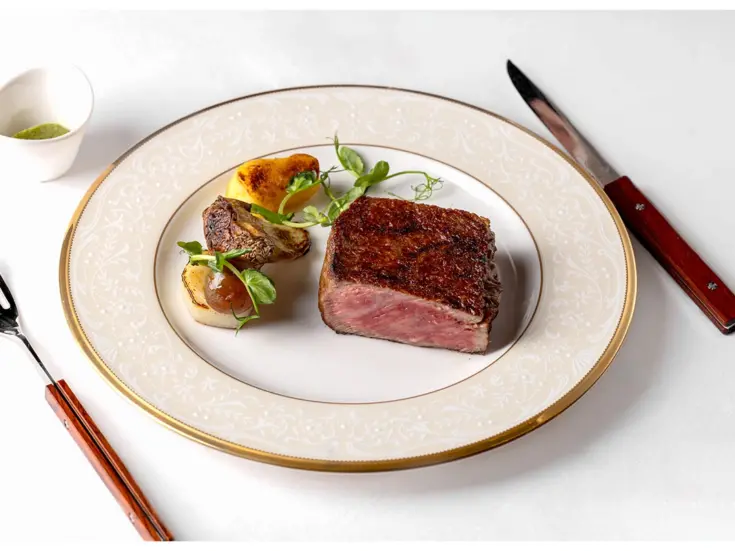
Danish cuisine has long been about more than herring. Douglas Blyde travels to Copenhagen to meet the designers behind noma, the world’s best restaurant
SLENDER SIGNE BINDSLEV Henriksen wears Farrah Fawcett’s hair while Bluto-whiskered Peter Bundgaard Rützou boasts rather little on top. The minds behind SPACE architects met at school and proceeded to be eachothers best competitors until joining forces in 2005.
I meet the handsome duo on their return from an adrenaline-fuelled excursion to Shanghai where they’re launching a line of chairs, tables and screens. The brand, ‘Stellar Works’, is intended to gentrify the image of the phrase, ‘Made in China’. Complete with what Henriksen terms ‘Asian flourishes’ including pagoda-like ‘smoothed, flared knuckles’, the team hopes the furniture will age well if it’s allowed to in such a furiously-paced cultural climate. ‘It’s evocative of 1960s New York over there,’ appraises Rützou, eyes shining.
Henriksen, who has lived in Kyoto and once designed film and theatre sets mentions she’s the partnership’s smooth personality while Rützou, who studied theoretical maths and believes it can explain ‘almost everything’, is therefore ‘rougher’. However, as with their projects, Henriksen and Rützou defy such easy definition. Rützou says: ‘Why do you walk along a beach, see a rock and have to pick it up? Emotions work a little faster than your mind.’ Their philosophy is summarised as thinking globally while caring locally and avoiding the straight-jacketing notion of fitting ‘isms’.
Flooded by eight windows SPACE’s practice unfurls by the river at Ravnsborg Tværgade beyond an antiques shop and covered parking bay where Henriksen tells me two homeless ‘used to party’ under a salvaged glitter ball. Although Henriksen and Rützou face each other at tidy desks, Rützou jokes that over the years a separating partition of computer screens has grown in altitude.
Contrasting a long matt black table are prototypes of ‘Liquid’, SPACE’s range of curvaceous bowls for artisan silversmith, Georg Jensen. There’s also a plate of dark organic chocolates and bottle of sparkling Hildon. Both are chilled. ‘I love this water’s soft bubbles,’ says Henriksen, clasping the frosted glass with slim fingers, ‘and there‘s only a few places that have it here.’ Next to us, after a low library of books including 40 Under 40: Young Architects for the New Millennium (Henriksen’s 38, Rützou’s 44), sit the firm’s six employees. Samples of slates, tiles and woods inhabit a corner, as do numbered chair legs evoking redundant peg legs.
Rützou says SPACE handles up to twenty projects at a time. Although commercial operations are inevitably of grander scale, those for income tax paying private clients can seem more demanding. ‘Sometimes we’re called five years in the future when the toilet’s flushing the wrong way,’ says Rützou, smirk building. ‘So call the fucking plumber!’
ALTHOUGH PROJECTS HAVE often evolved into being high profile, there are no plans to expand, ‘which is why we’ve kept small to protect our identity and focus on all parts of the process,’ explains Rützou. Such dedication can result in an uncapped workload. ‘We don’t count hours,’ Rützou says coolly. ‘But once in a while it’s good to take a trip without a designated purpose.’
Reasoning that ‘we have to eat, so why not celebrate it?’ SPACE specialises in restaurant design, liaising closely with leading chefs. Meaning ‘spirit’, Geist (pictured below), which opened this spring faces Kongens Nytorv, Copenhagen’s largest square. The scheme’s intended to capture the flamboyance of Bo Bech who hosts Denmark’s version of Kitchen Nightmares. ‘He can seem childish and let emotions get the better of him,’ says Henriksen. ‘And he likes the atmosphere of people,’ Rützou adds.
Serving up to 170 and tonight brimming with high school graduates in sailors’ berets, the bar has an abundance of dark wood counters met by stools which offer what Henriksen describes as ‘many ways to sit’. Above a tall table for eleven beside original, distressed cupboards is a dimmed chandelier of Georg Jensen seconds, arranged one night by Henriksen in inspired mood. Contrasting art nouveau panels is the smooth floor of magnified terrazzo. A wall of work by emerging artists gradually encroaches. A model of studied casualness, staff wear rough fringed T-shirts and daringly tight ACNE jeans.

In the dining room, pillars are topped by torpedo fins. Thick framed mirrors appear and untreated wood table tops require a feed of polish every morning. It’s relaxed, brasserie-like and evidently seducing Danes from their homes earlier in the week than is traditional. Rützou glances at clientele and staff before asserting Scandinavia’s growth in ‘single culture’.
‘We wanted Bo to call it “Beast”,’ says Henriksen, ‘but when he put that idea to his Facebook friends they disagreed.’
Contrasting Geist’s informality is Geranium (below), the cool, crisp international face of Scandinavian cuisine by Rasmus Kofoed, current winner of the global Bocuse d’Or competition. Henriksen mentions that to cook to victory, Kofoed practiced his menu over 3,000 hours. Unusually for Copenhagen where few structures exceed five floors, it’s located on the eighth storey of the built-for-purpose-rather-than-beauty national football stadium. Only serving organic and biodynamic produce it’s an unlikely but micro-considered haven of cosseting chairs and low lit, low tables, far removed from the din of team sport and heavy plant burrowing far below to insert the metro.
Bookended by a silvery marble fringed mirror is a subtly irregular fringe of lines. This detail’s intended ‘to fuck it up a bit’ says Rützou. At the other end are flames tamed in glass where a tasting of biodynamic Burgundy’s underway. A budless branch motif regularly sprouts, most visible on panels of the show kitchen.

Emphasised by the corporate sounding ping of a lift, Henriksen mentions how SPACE triumphed constrictions of a suite originally intended as offices. ‘Our challenge was to bring charm into an extremely un-charming building.’ ‘And to be light, but not too light,’ adds Rützou. ‘You wouldn’t believe some of graffiti in elevator left by workers,’ smiles Henriksen, as we enter the cabinet.
BACK TO STREET level and to the waterfront at Christianshavn, noma (from ‘nordisk mad’ or Nordic food) spans a former herring warehouse and has held, two years in a row, title of Restaurant Magazine’s World’s Best. Henriksen and Rützou have dined here no fewer than eleven times, effectively making a hallowed gourmet’s goal their local. ‘There’s something impressive about insistence,’ says Rützou of Albanian-born head chef René Redzepi’s journey towards perfection. In realisation of this goal, SPACE often render design enhancements during its annual three week closure.

Yachts swan by. Henriksen says since noma was elevated to world’s number one, the airport’s seen an influx of private jets. But it’s far from ostentatious. Delicately framed wooden chairs wear Tuscan and Finnish sheeps’ fleeces, zinc cooling troughs for wine and homemade vegetable juices hang and hug chalk washed pillars, and ivory handled knives rarely mimic eachother. Almost familial waiters, including one from Brockley, wear light aprons which allow them to blend in, a culinary army in camouflage.
Finally we visit Kødbyens Fiskebar (Fish Bar), another intrepid opening considering its situation in the city’s low, coarse, utilitarian meatpacking district. Realised on a light budget, it’s headed by former noma sous chef, Anders Selmer. Despite its meat-stamp-like logo, fish transcends meat here. Beyond a worn butcher’s block is a long rectangular bar of reclaimed coving pointing towards a jellyfish populated aquarium evoking the TARDIS console.
Despite there being 60cm of spare space beyond the tatty ceiling, SPACE didn’t take it, preferring the current defiantly warts and all approach to the loftiness of a grand brasserie. ‘We’re not keen on over-design,’ says Rützou as he pours Arwen, a Solaris, Sauvignon Blanc, Silvaner and Riesling blend made by Selmer on Danish island, Lilleø. Arwen is named after Redzepi’s daughter.
Having conquered Copenhagen’s restaurant scene, I ask what’s next on SPACE’s agenda. While both parties are united by the desire to design restaurants in London (an hour and a half plane ride separates the cities), Henriksen’s keen to get her teeth into ‘a whole hotel’ while Rützou’s interested in designing a surgery.
It’s hard to précis what united the four projects I saw. Certainly there’s a priority to let in the light, mandatory considering this northern country’s prolonged, dark winters. But what’s overwhelmingly transparent is Henriksen and Rützou’s overall objectivity and absolute determination and ability to playfully draw out an operator’s persona. Like their own personalities, their rich schemes are of opposing but complimentary textures. Rather than printed they’re felt and ultimately built to last.








